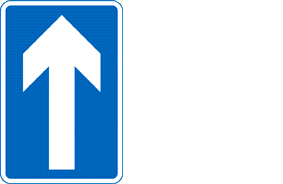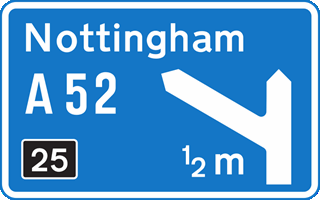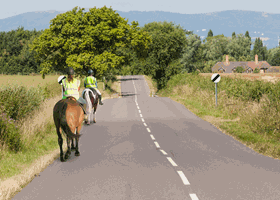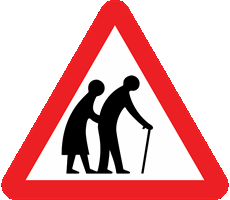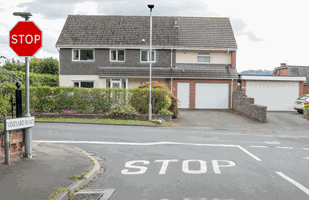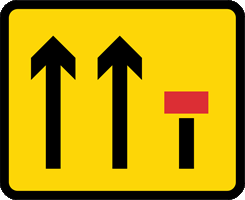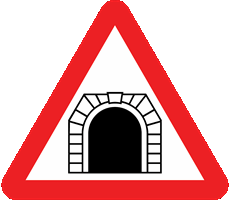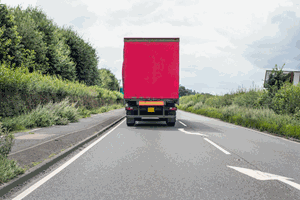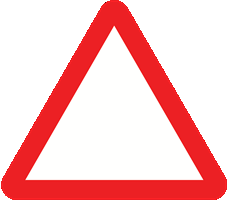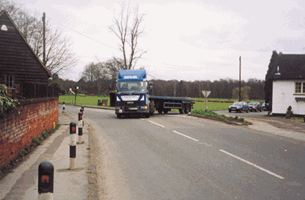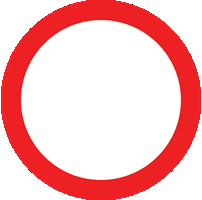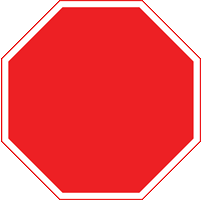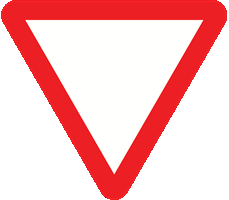You have 57 minutes to answer 50 multiple choice driving theory test questions. At least 43 out of 50 questions must be answered correctly in order to pass the test. Answers may be reviewed after each question or you can wait until the end of the test for your final score. Good luck!
Test Quick View
Click question box to reveal the correct answer. You can print these questions out by clicking the printer icon.
1. You're turning right onto a dual carriageway. What should you do before emerging?
Mark one answer
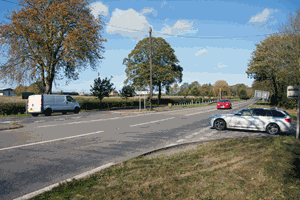
B
C
D
Correct Answer: A
Explanation: Before emerging right onto a dual carriageway, make sure that the central reservation is deep enough to protect your vehicle. If it isn't, you should treat the dual carriageway as one road and check that it's clear in both directions before pulling out. Neglecting to do this could place part or all of your vehicle in the path of approaching traffic and cause a collision.
Explanation: Before emerging right onto a dual carriageway, make sure that the central reservation is deep enough to protect your vehicle. If it isn't, you should treat the dual carriageway as one road and check that it's clear in both directions before pulling out. Neglecting to do this could place part or all of your vehicle in the path of approaching traffic and cause a collision.
2. You're looking for somewhere to park your vehicle. What should you do if the only free spaces are marked for disabled drivers?
Mark one answer
B
C
D
Correct Answer: D
Explanation: It's illegal to park in a space reserved for disabled drivers unless you're permitted to do so. These spaces are provided for people with limited mobility, who may need extra space to get in and out of their vehicle.
Explanation: It's illegal to park in a space reserved for disabled drivers unless you're permitted to do so. These spaces are provided for people with limited mobility, who may need extra space to get in and out of their vehicle.
3. How will you benefit from following the manufacturer's service schedule for your vehicle?
Mark one answer
B
C
D
Correct Answer: D
Explanation: All vehicles need to be serviced to keep working efficiently. An efficient engine uses less fuel and produces fewer harmful emissions than an engine that's running inefficiently. Keeping the vehicle serviced to the manufacturer's schedule should also keep it reliable and reduce the chance of it breaking down.
Explanation: All vehicles need to be serviced to keep working efficiently. An efficient engine uses less fuel and produces fewer harmful emissions than an engine that's running inefficiently. Keeping the vehicle serviced to the manufacturer's schedule should also keep it reliable and reduce the chance of it breaking down.
4. You're stopped at the side of the road. What must you do if you'll be waiting there for some time?
Mark one answer
B
C
D
Correct Answer: B
Explanation: If your vehicle is stationary and is likely to remain so for some time, you must switch off the engine unless you're stationary in traffic or diagnosing a fault.
Explanation: If your vehicle is stationary and is likely to remain so for some time, you must switch off the engine unless you're stationary in traffic or diagnosing a fault.
Correct Answer: D
Explanation: Motorcycles and scooters are generally smaller than other vehicles and can be difficult to see. Wearing bright clothing makes it easier for other road users to see a motorcyclist approaching, especially at junctions.
Explanation: Motorcycles and scooters are generally smaller than other vehicles and can be difficult to see. Wearing bright clothing makes it easier for other road users to see a motorcyclist approaching, especially at junctions.
Correct Answer: A
Explanation: In a one-way system, traffic may pass you on either side. Always be aware of all traffic signs and understand their meaning. Look well ahead and react to them in good time.
Explanation: In a one-way system, traffic may pass you on either side. Always be aware of all traffic signs and understand their meaning. Look well ahead and react to them in good time.
Correct Answer: B
Explanation: Having your vehicle broken into or stolen can be very distressing and inconvenient. Avoid leaving your vehicle unattended in poorly lit areas.
Explanation: Having your vehicle broken into or stolen can be very distressing and inconvenient. Avoid leaving your vehicle unattended in poorly lit areas.
Correct Answer: A
Explanation: By standing on the pavement, the pedestrian is showing an intention to cross. By looking well ahead, you'll give yourself time to see the pedestrian, check your mirrors and respond safely.
Explanation: By standing on the pavement, the pedestrian is showing an intention to cross. By looking well ahead, you'll give yourself time to see the pedestrian, check your mirrors and respond safely.
Correct Answer: B
Explanation: Before you set out on your journey, use a road map to plan your route. When you see an advance warning of your junction, make sure you get into the correct lane in plenty of time. Last-minute harsh braking and cutting across lanes at speed is extremely hazardous.
Explanation: Before you set out on your journey, use a road map to plan your route. When you see an advance warning of your junction, make sure you get into the correct lane in plenty of time. Last-minute harsh braking and cutting across lanes at speed is extremely hazardous.
Correct Answer: B
Explanation: As the registered keeper of a vehicle, it's up to you to inform DVLA of any changes in your details; for example, your name or address. You do this by completing and sending off the relevant section of the registration certificate.
Explanation: As the registered keeper of a vehicle, it's up to you to inform DVLA of any changes in your details; for example, your name or address. You do this by completing and sending off the relevant section of the registration certificate.
11. You're about to drive your car. What should you do if you can't find the glasses you need to wear?
Mark one answer
B
C
D
Correct Answer: D
Explanation: If you need to wear glasses for driving, it's illegal to drive without them. You must be able to see clearly when you're driving.
Explanation: If you need to wear glasses for driving, it's illegal to drive without them. You must be able to see clearly when you're driving.
12. What can people who live or work in towns and cities do to help reduce urban pollution levels?
Mark one answer
B
C
D
Correct Answer: D
Explanation: Using a vehicle for short journeys means the engine doesn't have time to reach its normal operating temperature. When an engine is running below its normal operating temperature, it produces increased amounts of pollution. Walking and cycling don't create pollution and have health benefits as well.
Explanation: Using a vehicle for short journeys means the engine doesn't have time to reach its normal operating temperature. When an engine is running below its normal operating temperature, it produces increased amounts of pollution. Walking and cycling don't create pollution and have health benefits as well.
B
C
D
Correct Answer: A
Explanation: Motorcyclists and cyclists are often more difficult to see at junctions. They're easily hidden from view and you may not be able to see them approaching a junction if your view is partially blocked; for example, by other traffic.
Explanation: Motorcyclists and cyclists are often more difficult to see at junctions. They're easily hidden from view and you may not be able to see them approaching a junction if your view is partially blocked; for example, by other traffic.
Correct Answer: B
Explanation: You mustn't use hazard warning lights while moving, except to warn traffic behind when you slow suddenly on a motorway or unrestricted dual carriageway. Never use hazard warning lights to excuse dangerous or illegal parking.
Explanation: You mustn't use hazard warning lights while moving, except to warn traffic behind when you slow suddenly on a motorway or unrestricted dual carriageway. Never use hazard warning lights to excuse dangerous or illegal parking.
Correct Answer: C
Explanation: No-one likes to spend time in traffic queues. Try to avoid busy times related to school or work travel.
Explanation: No-one likes to spend time in traffic queues. Try to avoid busy times related to school or work travel.
Correct Answer: C
Explanation: Be particularly careful when approaching horse riders - slow down and be prepared to stop. Always pass wide and slowly, and look out for signals given by the riders. Horses are unpredictable: always treat them as potential hazards and take great care when passing them.
Explanation: Be particularly careful when approaching horse riders - slow down and be prepared to stop. Always pass wide and slowly, and look out for signals given by the riders. Horses are unpredictable: always treat them as potential hazards and take great care when passing them.
17. You have to arrive on time for an appointment. How should you plan for the journey?
Mark one answer
B
C
D
Correct Answer: A
Explanation: Always allow plenty of time for your journey in case of unforeseen problems. Anything can happen; for example, punctures, breakdowns, road closures, diversions and delays. You'll feel less stressed and less inclined to take risks if you aren't 'pushed for time'.
Explanation: Always allow plenty of time for your journey in case of unforeseen problems. Anything can happen; for example, punctures, breakdowns, road closures, diversions and delays. You'll feel less stressed and less inclined to take risks if you aren't 'pushed for time'.
18. You're following two cyclists as they approach a roundabout in the left-hand lane. Where would you expect the cyclists to go?
Mark one answer
B
C
D
Correct Answer: A
Explanation: Cyclists approaching a roundabout in the left-hand lane may be turning right but may not have been able to get into the correct lane due to heavy traffic. They may also feel safer keeping to the left all the way around the roundabout. Be aware of them and give them plenty of room.
Explanation: Cyclists approaching a roundabout in the left-hand lane may be turning right but may not have been able to get into the correct lane due to heavy traffic. They may also feel safer keeping to the left all the way around the roundabout. Be aware of them and give them plenty of room.
Correct Answer: D
Explanation: If you have to park your vehicle in foggy conditions, try to find a place to park off the road. If this isn't possible, park on the road facing in the same direction as the traffic. Leave your parking lights switched on and make sure they're clean.
Explanation: If you have to park your vehicle in foggy conditions, try to find a place to park off the road. If this isn't possible, park on the road facing in the same direction as the traffic. Leave your parking lights switched on and make sure they're clean.
20. What should you do about driving if you've been taking medicine that causes drowsiness?
Mark one answer
B
C
D
Correct Answer: B
Explanation: You aren't fit to drive if you're taking medicine that makes you drowsy. Check with your doctor if you're unsure. You mustn't put other road users, your passengers or yourself at risk.
Explanation: You aren't fit to drive if you're taking medicine that makes you drowsy. Check with your doctor if you're unsure. You mustn't put other road users, your passengers or yourself at risk.
Correct Answer: A
Explanation: Be aware that older people might take a long time to cross the road. They might also be hard of hearing and not hear you approaching. Don't hurry older people across the road by getting too close to them or revving your engine.
Explanation: Be aware that older people might take a long time to cross the road. They might also be hard of hearing and not hear you approaching. Don't hurry older people across the road by getting too close to them or revving your engine.
22. What should you do when you're approaching traffic lights that have red and amber showing together?
Mark one answer
B
C
D
Correct Answer: D
Explanation: Be aware that other traffic might still be clearing the junction as you approach. A green light means you may go on, but only if the way is clear.
Explanation: Be aware that other traffic might still be clearing the junction as you approach. A green light means you may go on, but only if the way is clear.
Correct Answer: D
Explanation: When a smart motorway is operating, you must follow the mandatory signs on the gantries above each lane, including the hard shoulder. Variable speed limits help keep the traffic moving and also help to prevent bunching.
Explanation: When a smart motorway is operating, you must follow the mandatory signs on the gantries above each lane, including the hard shoulder. Variable speed limits help keep the traffic moving and also help to prevent bunching.
Correct Answer: D
Explanation: A warning sign with a picture of a windsock indicates that there may be strong side winds. This sign is often found on exposed roads.
Explanation: A warning sign with a picture of a windsock indicates that there may be strong side winds. This sign is often found on exposed roads.
25. You're on a road that's only wide enough for one vehicle. What should you do if a car is coming towards you?
Mark one answer
B
C
D
Correct Answer: C
Explanation: Pull into the nearest passing place on the left if you meet another vehicle on a narrow road. If the nearest passing place is on the right, wait opposite it.
Explanation: Pull into the nearest passing place on the left if you meet another vehicle on a narrow road. If the nearest passing place is on the right, wait opposite it.
Correct Answer: D
Explanation: The vehicle you drive must be roadworthy and in good condition. If it's over three years old, it must pass an MOT test to remain in use on the road (unless it's exempt from the MOT test - see GOV.UK).
Explanation: The vehicle you drive must be roadworthy and in good condition. If it's over three years old, it must pass an MOT test to remain in use on the road (unless it's exempt from the MOT test - see GOV.UK).
Correct Answer: A
Explanation: Your tyres may be of different treads and makes. They can even be second-hand, as long as they're in good condition. They must, however, be intact, without cuts or tears. When checking the side walls for cuts and bulges, don't forget to check the side of the tyre that's hidden from view, under the car.
Explanation: Your tyres may be of different treads and makes. They can even be second-hand, as long as they're in good condition. They must, however, be intact, without cuts or tears. When checking the side walls for cuts and bulges, don't forget to check the side of the tyre that's hidden from view, under the car.
Correct Answer: C
Explanation: You won't be able to drive unaccompanied until you've passed your practical driving test. If you haven't driven on the motorway while you were learning, ask your instructor to take you for a lesson on the motorway when you've passed your test. Alternatively, you could take part in the Pass Plus scheme. This has been created for new drivers and includes motorway driving. Ask your instructor for details.
Explanation: You won't be able to drive unaccompanied until you've passed your practical driving test. If you haven't driven on the motorway while you were learning, ask your instructor to take you for a lesson on the motorway when you've passed your test. Alternatively, you could take part in the Pass Plus scheme. This has been created for new drivers and includes motorway driving. Ask your instructor for details.
Correct Answer: B
Explanation: The emphasis is on hazard awareness and planning ahead. By looking well ahead, you'll have plenty of time to deal with hazards safely and won't need to brake sharply. This will also reduce damage to the environment.
Explanation: The emphasis is on hazard awareness and planning ahead. By looking well ahead, you'll have plenty of time to deal with hazards safely and won't need to brake sharply. This will also reduce damage to the environment.
Correct Answer: D
Explanation: White studs are found between the lanes on motorways. They reflect back the light from your headlights. This is especially useful in bad weather, when visibility is restricted.
Explanation: White studs are found between the lanes on motorways. They reflect back the light from your headlights. This is especially useful in bad weather, when visibility is restricted.
31. You're in a one-way street and want to turn right. Where should you position your vehicle when there are two lanes?
Mark one answer
B
C
D
Correct Answer: C
Explanation: When you're in a one-way street and want to turn right, you should take up a position in the right-hand lane. This will allow other road users, not wishing to turn, to pass on the left. Indicate your intention and take up the correct position in good time.
Explanation: When you're in a one-way street and want to turn right, you should take up a position in the right-hand lane. This will allow other road users, not wishing to turn, to pass on the left. Indicate your intention and take up the correct position in good time.
Correct Answer: A
Explanation: The 'stop' sign has been put here because the view into the main road is poor. You must stop because it won't be possible to take proper observation while you're moving.
Explanation: The 'stop' sign has been put here because the view into the main road is poor. You must stop because it won't be possible to take proper observation while you're moving.
33. You're driving in heavy traffic on a wet road. Which lights should you use if there's a lot of surface spray?
Mark one answer
B
C
D
Correct Answer: A
Explanation: You must make sure that other road users can see you, but you don't want to dazzle them. Use your dipped headlights during the day if visibility is poor. If visibility falls below 100 metres (328 feet), you may use your rear fog lights, but don't forget to turn them off when the visibility improves.
Explanation: You must make sure that other road users can see you, but you don't want to dazzle them. Use your dipped headlights during the day if visibility is poor. If visibility falls below 100 metres (328 feet), you may use your rear fog lights, but don't forget to turn them off when the visibility improves.
34. Your vehicle has broken down on a motorway. In which direction should you walk to find the nearest emergency telephone?
Mark one answer
B
C
D
Correct Answer: C
Explanation: Along the hard shoulder there are marker posts at 100-metre intervals. These will direct you to the nearest emergency telephone.
Explanation: Along the hard shoulder there are marker posts at 100-metre intervals. These will direct you to the nearest emergency telephone.
Correct Answer: D
Explanation: Yellow-and-black temporary signs may be used to inform you about roadworks or lane restrictions. Look well ahead. If you have to change lanes, do so in good time.
Explanation: Yellow-and-black temporary signs may be used to inform you about roadworks or lane restrictions. Look well ahead. If you have to change lanes, do so in good time.
36. As you approach a pelican crossing, the lights change to green. What should you do if older people are still crossing?
Mark one answer
B
C
D
Correct Answer: C
Explanation: If the lights turn to green, wait for any pedestrians to clear the crossing. Allow them to finish crossing the road in their own time, and don't try to hurry them by revving your engine.
Explanation: If the lights turn to green, wait for any pedestrians to clear the crossing. Allow them to finish crossing the road in their own time, and don't try to hurry them by revving your engine.
37. You're waiting to turn right at the end of a road. What should you do if your view is obstructed by parked vehicles?
Mark one answer
B
C
D
Correct Answer: B
Explanation: At junctions, your view is often restricted by buildings, trees or parked cars. You need to be able to see in order to judge a safe gap. Edge forward slowly and keep looking all the time. Don't cause other road users to change speed or direction as you emerge.
Explanation: At junctions, your view is often restricted by buildings, trees or parked cars. You need to be able to see in order to judge a safe gap. Edge forward slowly and keep looking all the time. Don't cause other road users to change speed or direction as you emerge.
Correct Answer: D
Explanation: Extra care should be taken in wet weather. On wet roads, your stopping distance could be double that in dry conditions.
Explanation: Extra care should be taken in wet weather. On wet roads, your stopping distance could be double that in dry conditions.
39. You see a horse rider as you approach a roundabout. What should you do if they're signalling right but keeping well to the left?
Mark one answer
B
C
D
Correct Answer: D
Explanation: Allow the horse rider to enter and exit the roundabout in their own time. They may feel safer keeping to the left all the way around the roundabout. Don't get up close behind or alongside them, because that would probably upset the horse and create a dangerous situation.
Explanation: Allow the horse rider to enter and exit the roundabout in their own time. They may feel safer keeping to the left all the way around the roundabout. Don't get up close behind or alongside them, because that would probably upset the horse and create a dangerous situation.
40. You're travelling in the left-hand lane of a three-lane motorway. How should you react to traffic joining from a slip road?
Mark one answer
B
C
D
Correct Answer: A
Explanation: Plan well ahead when approaching a slip road. If you see traffic joining the motorway, be prepared to adjust your speed or move to another lane if it's safe to do so. This can help the flow of traffic joining the motorway, especially at peak times.
Explanation: Plan well ahead when approaching a slip road. If you see traffic joining the motorway, be prepared to adjust your speed or move to another lane if it's safe to do so. This can help the flow of traffic joining the motorway, especially at peak times.
Correct Answer: A
Explanation: You mustn't use your vehicle's horn between 11.30 pm and 7 am in a built-up area or when you're stationary, unless a moving vehicle poses a danger. Its function is to alert other road users to your presence.
Explanation: You mustn't use your vehicle's horn between 11.30 pm and 7 am in a built-up area or when you're stationary, unless a moving vehicle poses a danger. Its function is to alert other road users to your presence.
Correct Answer: D
Explanation: When approaching a tunnel, switch on your dipped headlights. Be aware that your eyes might need to adjust to the sudden darkness. You may need to reduce your speed.
Explanation: When approaching a tunnel, switch on your dipped headlights. Be aware that your eyes might need to adjust to the sudden darkness. You may need to reduce your speed.
Correct Answer: D
Explanation: Staying back will increase your view of the road ahead. This will help you to see any hazards that might occur and give you more time to react.
Explanation: Staying back will increase your view of the road ahead. This will help you to see any hazards that might occur and give you more time to react.
Correct Answer: D
Explanation: Warning signs are there to make you aware of potential hazards on the road ahead. Take note of the signs so you're prepared and can take whatever action is necessary.
Explanation: Warning signs are there to make you aware of potential hazards on the road ahead. Take note of the signs so you're prepared and can take whatever action is necessary.
Correct Answer: A
Explanation: DVLA needs to keep its records up to date. It sends out a reminder when a vehicle's tax is due for renewal. To do this, it needs to know the name and address of the registered keeper. Every vehicle in the country is registered, so it's possible to trace its history.
Explanation: DVLA needs to keep its records up to date. It sends out a reminder when a vehicle's tax is due for renewal. To do this, it needs to know the name and address of the registered keeper. Every vehicle in the country is registered, so it's possible to trace its history.
46. You're driving along this road. What should you do if the red car cuts in close in front of you?
Mark one answer
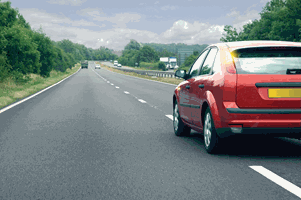
B
C
D
Correct Answer: B
Explanation: There are times when other drivers make incorrect or ill-judged decisions. Be tolerant and try not to retaliate or react aggressively. Always consider the safety of other road users, your passengers and yourself.
Explanation: There are times when other drivers make incorrect or ill-judged decisions. Be tolerant and try not to retaliate or react aggressively. Always consider the safety of other road users, your passengers and yourself.
Correct Answer: B
Explanation: Sometimes, large vehicles may need more space than other road users. If a vehicle needs more time and space to turn, be prepared to stop and wait.
Explanation: Sometimes, large vehicles may need more space than other road users. If a vehicle needs more time and space to turn, be prepared to stop and wait.
48. You're following a cyclist. What should you do when you wish to turn left a short distance ahead?
Mark one answer
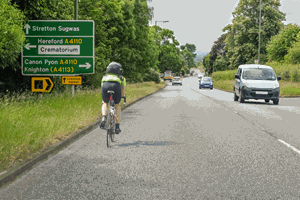
B
C
D
Correct Answer: B
Explanation: Make allowances for cyclists, and give them plenty of room. Don't overtake and then immediately turn left. Be patient and turn behind them when they've passed the junction.
Explanation: Make allowances for cyclists, and give them plenty of room. Don't overtake and then immediately turn left. Be patient and turn behind them when they've passed the junction.
Correct Answer: D
Explanation: Try not to use your car as a matter of routine. For shorter journeys, consider walking or cycling instead - this is much better for both you and the environment.
Explanation: Try not to use your car as a matter of routine. For shorter journeys, consider walking or cycling instead - this is much better for both you and the environment.
Correct Answer: D
Explanation: Other warning signs are the same shape and colour, but the 'give way' triangle points downwards. When you see this sign, you must give way to traffic on the road that you're about to enter.
Explanation: Other warning signs are the same shape and colour, but the 'give way' triangle points downwards. When you see this sign, you must give way to traffic on the road that you're about to enter.


